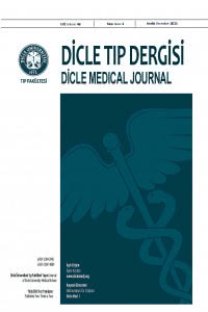Deneysel Hipertansiyon Modelinde Farklı DOCA-tuz Uygulama Sürelerinin Kan Basıncı ve Damar Cevapları Üzerine Etkisi
The Effect of Different Application Periods of DOCA-salt on Blood Pressure and Vascular Response in the Experimental Model of Hypertension
___
- 1. Sözmen K, Ergör G, Ünal B. Hipertansiyon sıklığı, farkındalığı, tedavi alma ve kan basıncı kontrolünü etkileyen etmenler. Dicle Medical Journal / Dicle Tip Dergisi. 2015;42:199-207.
- 2. Basting T, Lazartigues E. DOCA-Salt Hypertension: an Update. Curr Hypertens Rep. 2017;19:32.
- 3. Lerman LO, Kurtz TW, Touyz RM, et al. Animal Models of Hypertension: A Scientific Statement From the American Heart Association. Hypertension. 2019:HYP0000000000000090.
- 4. Carretero OA, Oparil S. Essential hypertension. Part I: definition and etiology. Circulation. 2000;101:329-35.
- 5. Guyenet PG. The sympathetic control of blood pressure. Nat Rev Neurosci. 2006;7:335-46.
- 6. Crowley SD, Coffman TM. In hypertension, the kidney breaks your heart. Curr Cardiol Rep. 2008;10:470-6.
- 7. Takeda K, Nakamura Y, Hayashi J, et al. Effects of Salt and Doca on Hypothalamic and Baroreflex Control of Blood-Pressure. Clinical and Experimental Hypertension Part a-Theory and Practice. 1988;10:289- 99.
- 8. Takeda K, Nakamura Y, Oguro M, et al. Central Attenuation of Baroreflex Precedes the Development of Hypertension in Doca-Salt-Treated Rats. American Journal of Hypertension. 1988;1:S23-S5.
- 9. Takeda K, Nakamura Y, Okajima H, et al. AttenuatedCardiovascularandSympathetic-Nerve Responses to Aortic Nerve-Stimulation in Doca-Salt Hypertensive Rats. Journal of Hypertension. 1988;6:559-63.
- 10. Ueno Y, Mohara O, Brosnihan KB, Ferrario CM. Characteristics of hormonal and neurogenic mechanisms of deoxycorticosterone-induced hypertension. Hypertension. 1988;11:I172-7.
- 11. Sapouckey SA, Deng G, Sigmund CD, Grobe JL. Potential mechanisms of hypothalamic reninangiotensin system activation by leptin and DOCA-salt for the control of resting metabolism. Physiol Genomics. 2017;49:722-32.
- 12. Han S, Bal NB, Sadi G et al. Inhibition of endoplasmic reticulum stress protected DOCA-salt hypertensioninduced vascular dysfunction. Vascul Pharmacol. 2019;113:38-46.
- 13. Han S, Bal NB, Sadi G, et al. Theeffects of LXR agonist GW3965 on vascular reactivity and inflammation in hypertensive rat aorta. Life Sci. 2018;213:287-93.
- 14. Han S, Uludag MO, Usanmaz SE, et al. Resveratrol affects histone 3 lysine 27 methylation of vessels and blood biomarkers in DOCA salt-induced hypertension. Mol Biol Rep. 2015;42:35-42.
- 15. Cassinotti LR, Guil MJ, Scholler MI, et al. Chronic Blockade of Brain Endothelin ReceptorType-A (ETA) Reduces Blood Pressure and Prevents Catecholaminergic Overactivity in the Right Olfactory Bulb of DOCA-Salt Hypertensive Rats. Int J Mol Sci. 2018;19.
- 16. Bae EH, Kim IJ, Song JH et al. Renoprotective Effect of the Histone Deacetylase Inhibitor CG200745 in DOCASalt Hypertensive Rats. Int J MolSci. 2019;20.
- 17. Kubacka M, Zadrozna M, Nowak B, et al. Reversal of cardiac, vascular, andrenal dysfunction by nonquinazoline alpha1-adrenolytics in DOCA-salt hypertensive rats: a comparison with prazosin, a quinazoline-based alpha1-adrenoceptor antagonist. Hypertens Res. 2019.
- 18. Jamwal S, Sharma S. Vascular endothelium dysfunction: a conservative target in metabolic disorders. Inflamm Res. 2018;67:391-405.
- 19. Ye F, Wu Y, Chen Y, Xiao D, Shi L. Impact of moderateand high-intensity exercise on the endothelial ultrastructure and function in mesenteric arteries from hypertensive rats. Life Sci. 2019;222:36-45.
- 20. Niazi ZR, Silva GC, Ribeiro TP, et al. EPA:DHA 6:1 prevents angiotensin II-induced hypertension and endothelial dysfunction in rats: role of NADPH oxidaseand COX-derived oxidative stress. Hypertens Res. 2017;40:966-75.
- 21. Mordi I, Mordi N, Delles C, Tzemos N. Endothelial dysfunction in human essential hypertension. J Hypertens. 2016;34:1464-72.
- 22. Bockman CS, Jeffries WB, Pettinger WA, Abel PW. Enhanced release of endothelium-derived relaxing factor in mineralocorticoid hypertension. Hypertension. 1992;20:304-13.
- 23. Galisteo M, Garcia-Saura MF, Jimenez R, et al. Effects of quercetin treatment on vascular function in deoxycorticosteroneacetate-salt hypertensive rats. Comparative study with verapamil. Planta Med. 2004;70:334-41.
- 24. Goulopoulou S, Webb RC. Symphony of Vascular Contraction How Smooth Muscle Cells Lose Harmony to Signal Increased Vascular Resistance in Hypertension. Hypertension. 2014;63:E33-E9.
- 25. Sonkusare S, Palade PT, Marsh JD, et al. Vascular calcium channels and high blood pressure: Pathophysiology and therapeutic implications. Vascular Pharmacology. 2006;44:131-42.
- ISSN: 1300-2945
- Yayın Aralığı: 4
- Başlangıç: 1963
- Yayıncı: Cahfer GÜLOĞLU
Larenks Skuamöz Hücreli Karsinom Örneklerinde Pepsin Araştırılması
Hakan BİRKENT, Burcu ESER, Hamdi TAŞLI, Burak AŞIK, Mustafa GEREK
Muhammed Cihan TEMEL, Serkan AKAN, Caner Ediz, Neslihan KAYA TERZİ, Ömer YILMAZ
Bir Çocukta Akut Abdomenin Nadir Nedeni: Enfekte Mezenterik Kist
Sefa SAĞ, Burcu KEMAL OKATAN, Nigar METİN
Cem MİRİLİ, Ali YILMAZ, MEHMET BİLİCİ, Salim Başol TEKİN
Yaşlanmaya İlişkin Testiküler Bozulmalarda MMP-2 ve VEGF'nin Olası Etkileşimi
Özgür GÖLGELİOĞLU, Mehmet ATEŞ, Güven GÜVENDİ, Sevim KANDİŞ, Servet KIZILDAĞ, Başar KOÇ, Ferda HOŞGÖRLER, Nazan UYSAL
Ünal ÖZTÜRK, Önder ÖZTÜRK, Yusuf TAMAM
FATİH AKSOY, İsmail Barkın IŞIK, Hasan Aydın BAŞ, Ali BAĞCI, Fatih KAHRAMAN, Yunus Emre OKUDAN, MEVLÜT SERDAR KUYUMCU, Ahmet ALTINBAŞ
Meme Kanserinde Brca-1 ve Brca-2’de Sık Görülen Polimorfizm Mutasyonların Bölgemizde Varlığı
MUSTAFA ZANYAR AKKUZU, Mehmet KÜÇÜKÖNER, Sevgi İRTEGUN, Nadiye AKDENİZ, Zuhat URAKÇI, MUHAMMET ALİ KAPLAN, HÜSEYİN BÜYÜKBAYRAM, Abdurrahman IŞIKDOĞAN
Nadir Yerleşimli Leiomyom Olgusu: Vajinal Leiomyoma
Melike DEMİR ÇALTEKİN, Demet AYDOĞAN KIRMIZI, Emre BAŞER, Taylan ONAT
